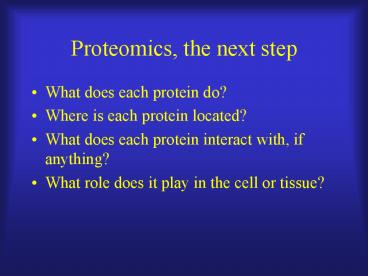Proteomics, the next step PowerPoint PPT Presentation
1 / 17
Title: Proteomics, the next step
1
Proteomics, the next step
- What does each protein do?
- Where is each protein located?
- What does each protein interact with, if
anything? - What role does it play in the cell or tissue?
2
Gene Ontology
- Biological process
- Molecular function
- Cellular component
- Kinda like the EC commission, a mechanism for
uniformity among disparate systems - http//www.geneontology.org/
3
Assigning ontology
- Functional genomics using mini-Tn
- Promoter-less lacZ with selectable markers ,
epitope tag and flanked by lox recombination
sites - Isolated gt11,000 Tn mutants that turn blue during
vegetative growth (transcription and translation
occur) - In addition to ontology, you also get info on
regulation (expression) via lacZ handle - 1917 ORFs/6358 strains were mutated at least
once, many multiple times
4
Macroarrays
- How do you examine that many yeast strains?
- Robots spot strains on agar plates, and plates
incubated under various conditions - Limited by number of conditions used 20 in this
study, some quite inventive
5
Caveats
- Can mutate same gene, with different effects
- 11 distinct insertions were characterized for
Imp2 - Observe differing effects on glycerol metabolism
an cell wall synthesis
6
Clustering
- Each column a condition, each row a mutant strain
which ones behave most similarly - Allows visualization of proteins involved in gt1
process or observing a potential role for an
uncharacterized ORF but how do you get ontology?
7
Everything you want
- Phenotypic analysis will divine with certainty at
least one biological process the gene is involved - Molecular function would have to be assessed
biochemically - Use epitope as localization tool
8
Bar coding genes
- Delete ORFs by homologous recombination and
replace with selectable marker and 20 bp DNA
sequences UPTAGS and DOWNTAGS - Each TAG (barcode) is unique to an ORF
- Can PCR amplify TAGS using same set of primers
- Construct a DNA barcode microarray
- Each mutant strain had two, and only two spots
that it would hybridize to
9
Contamination!
- With this strategy, the investigators mixed 558
strains in same flaskremoved samples at
different time points (first point label PCR
reaction red and second (6hrs later) label
green). - Use the microarray to determine which strains are
able to better compete
10
So
- Bar code methodology shows which proteins provide
a selective advantage in a mixed population of
cells - Two spots of different sequences provides an
internal control for the experiment
11
How do you know youve sampled enough cells?
- Binomial probability distribution
- Binary outcome, either get a 1 or 0
- If p is the probability of getting a 1 (in a
single trial), (1-p) is the probability of
getting a 0, then the probability that k out of N
tries gives a 1 is - P(k 1s out of N) (N over k) pk (1-p)N-k
12
pk (1-p)N-k
- These terms represent the probability of
observing a 1 with k successes and N- k failures
13
(N over k)
- This term counts the number of ways you get a 1
- (N over k) denotes the number of ways of choosing
k objects from N which is the factorial function
n!/k!(n-k)! - This is also known as the binomial coefficient
- Work through math minute 6.1
14
Structural Genomics
- Inferring function from structure (Archaea)
- Aquaporin structure/function
- Co-crystals as binding assays
- Prion protein in yeast Sup35
- Overproduction of prion protein in yeast leads to
infectious particle
15
Protein interaction networks
- Identified by comparative genomics analyses
neighbors interact - Yeast two-hybrid system
- Various repositories for interaction data
- BIND www.bind.ca
- DIP http//dip.doe-mbi.ucla.edu/hold/
16
Deciphering protein network graphs
- Node, edges, degrees
- Example in MM 6.2
- Calculate the mean and standard deviation for
degrees in any given network - If the degree of a node is gt than mean degree 2
S. D., it has high connectivity in that network
17
Schwikowski paper
- www.uwp.edu/barber/bioinformatics/benno.pdf
- Book web-site
- http//occawlonline.pearsoned.com/bookbind/pubbook
s/bc_mcampbell_genomics_1/chapter1/deluxe.html - Discovery questions 44-49 for next week

